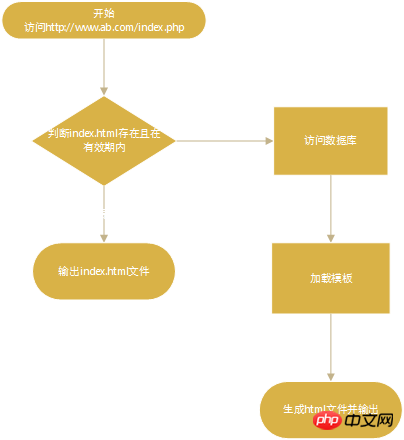这次给大家带来使用PHP页面静态化步骤详解,使用PHP页面静态化的注意事项有哪些,下面就是实战案例,一起来看一下。
页面静态化,顾名思义是将动态的PHP转化为静态的Html,流程如下图

用户访问index.php,如果存在index.html且在有效期内,则直接输出index.html,否则去生成index.html
file_put_contents()输出静态文件
ob_start()开启PHP缓冲区
ob_get_contents()获取缓冲区内容
ob_clean()清空缓冲区
ob_get_clean()相当于ob_get_contents()+ob_clean()
代码示例
<?php
if (file_exists('./html/index.html') && time() - filectime('./html/index.html') < 30) {
require_once './html/index.html';
} else {
// 引入数据库配置
require_once "./config/database.php";
// 引入Medoo类库
require_once "./libs/medoo.php";
// 实例化db对象
$db = new medoo($config);
// 获取数据
$users = $db->select('user', ['uid', 'username', 'email']);
// 引入模板
require_once "./templates/index.php";
// 写入html
file_put_contents('./html/index.html', ob_get_contents());
}
相信看了本文案例你已经掌握了方法,更多精彩请关注php中文网其它相关文章!
推荐阅读:
以上是使用PHP页面静态化步骤详解的详细内容。更多信息请关注PHP中文网其他相关文章!
 PHP如何识别用户的会话?May 01, 2025 am 12:23 AM
PHP如何识别用户的会话?May 01, 2025 am 12:23 AMphpientifiesauser'ssessionusessessionSessionCookiesAndSessionIds.1)whiwSession_start()被称为,phpgeneratesainiquesesesessionIdStoredInacookInAcookInamedInAcienamedphpsessidontheuser'sbrowser'sbrowser.2)thisIdAllowSphptptpptpptpptpptortoreTessessionDataAfromtheserverMtheserver。
 确保PHP会议的一些最佳实践是什么?May 01, 2025 am 12:22 AM
确保PHP会议的一些最佳实践是什么?May 01, 2025 am 12:22 AMPHP会话的安全可以通过以下措施实现:1.使用session_regenerate_id()在用户登录或重要操作时重新生成会话ID。2.通过HTTPS协议加密传输会话ID。3.使用session_save_path()指定安全目录存储会话数据,并正确设置权限。
 PHP会话文件默认存储在哪里?May 01, 2025 am 12:15 AM
PHP会话文件默认存储在哪里?May 01, 2025 am 12:15 AMphpsessionFilesArestoredIntheDirectorySpecifiedBysession.save_path,通常是/tmponunix-likesystemsorc:\ windows \ windows \ temponwindows.tocustomizethis:tocustomizEthis:1)useession_save_save_save_path_path()
 您如何从PHP会话中检索数据?May 01, 2025 am 12:11 AM
您如何从PHP会话中检索数据?May 01, 2025 am 12:11 AMToretrievedatafromaPHPsession,startthesessionwithsession_start()andaccessvariablesinthe$_SESSIONarray.Forexample:1)Startthesession:session_start().2)Retrievedata:$username=$_SESSION['username'];echo"Welcome,".$username;.Sessionsareserver-si
 您如何使用会议来实施购物车?May 01, 2025 am 12:10 AM
您如何使用会议来实施购物车?May 01, 2025 am 12:10 AM利用会话构建高效购物车系统的步骤包括:1)理解会话的定义与作用,会话是服务器端的存储机制,用于跨请求维护用户状态;2)实现基本的会话管理,如添加商品到购物车;3)扩展到高级用法,支持商品数量管理和删除;4)优化性能和安全性,通过持久化会话数据和使用安全的会话标识符。
 crypt()和password_hash()有什么区别?Apr 30, 2025 pm 03:39 PM
crypt()和password_hash()有什么区别?Apr 30, 2025 pm 03:39 PM本文讨论了PHP中的crypt()和password_hash()之间的差异,以进行密码哈希,重点介绍其实施,安全性和对现代Web应用程序的适用性。
 如何防止PHP中的跨站点脚本(XSS)?Apr 30, 2025 pm 03:38 PM
如何防止PHP中的跨站点脚本(XSS)?Apr 30, 2025 pm 03:38 PM文章讨论了通过输入验证,输出编码以及使用OWASP ESAPI和HTML净化器之类的工具来防止PHP中的跨站点脚本(XSS)。


热AI工具

Undresser.AI Undress
人工智能驱动的应用程序,用于创建逼真的裸体照片

AI Clothes Remover
用于从照片中去除衣服的在线人工智能工具。

Undress AI Tool
免费脱衣服图片

Clothoff.io
AI脱衣机

Video Face Swap
使用我们完全免费的人工智能换脸工具轻松在任何视频中换脸!

热门文章

热工具

DVWA
Damn Vulnerable Web App (DVWA) 是一个PHP/MySQL的Web应用程序,非常容易受到攻击。它的主要目标是成为安全专业人员在合法环境中测试自己的技能和工具的辅助工具,帮助Web开发人员更好地理解保护Web应用程序的过程,并帮助教师/学生在课堂环境中教授/学习Web应用程序安全。DVWA的目标是通过简单直接的界面练习一些最常见的Web漏洞,难度各不相同。请注意,该软件中

螳螂BT
Mantis是一个易于部署的基于Web的缺陷跟踪工具,用于帮助产品缺陷跟踪。它需要PHP、MySQL和一个Web服务器。请查看我们的演示和托管服务。

SublimeText3汉化版
中文版,非常好用

SecLists
SecLists是最终安全测试人员的伙伴。它是一个包含各种类型列表的集合,这些列表在安全评估过程中经常使用,都在一个地方。SecLists通过方便地提供安全测试人员可能需要的所有列表,帮助提高安全测试的效率和生产力。列表类型包括用户名、密码、URL、模糊测试有效载荷、敏感数据模式、Web shell等等。测试人员只需将此存储库拉到新的测试机上,他就可以访问到所需的每种类型的列表。

SublimeText3 Mac版
神级代码编辑软件(SublimeText3)






